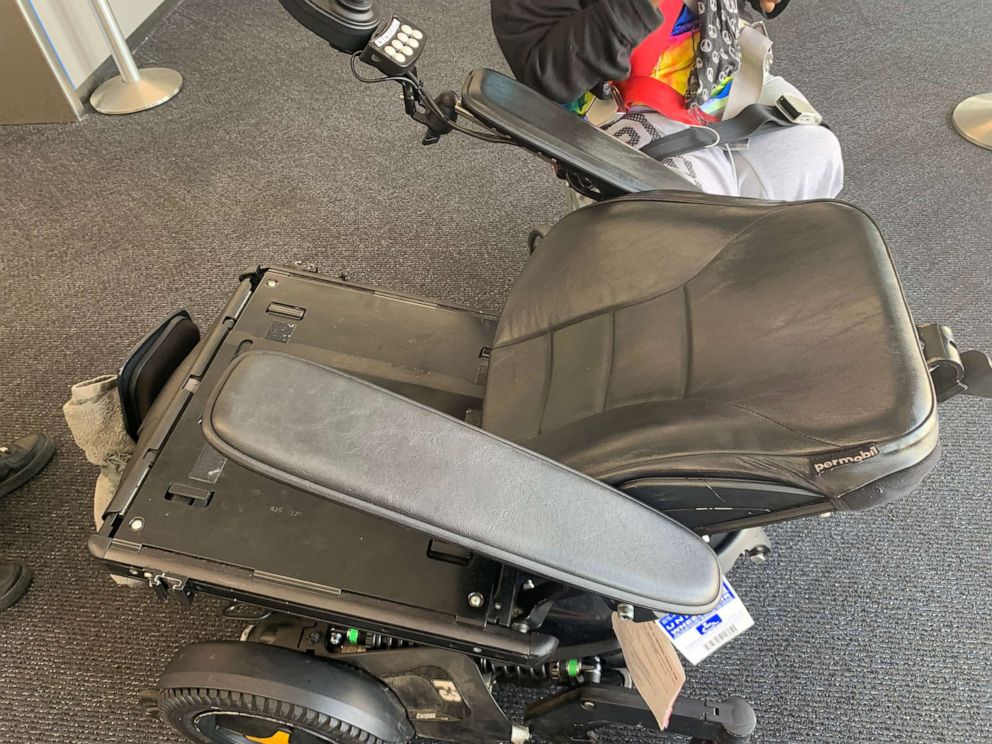(NEW YORK) — Thirty years ago Engracia Figueroa, 51, was hit by a Bay Area Rapid Transit train that left her with a spinal cord injury and amputated leg. She now calls her wheelchair an “extension of her body” — granting her freedom and independence.
But last week Figueroa says she was “re-disabled” when her $30,000 wheelchair was mangled in the cargo hold of a United flight.
“I was heartbroken,” she said when she first saw what she described as her “completely contorted” chair after her flight to Los Angeles. “I just thought, all of the independence that I fought and strived for and successfully survived for soon to be 30 years by the minute, it’s stripped away, and I was completely disabled and traumatized, as well as hurt and exhausted.”
Airlines are obligated to fix or replace damaged or lost wheelchairs under the Air Carrier Access Act.
“They’re attempting to fix it,” Figueroa told ABC News, but “there’s nothing to fix.”
“The chair is a total loss and to get a new wheelchair, it takes two months,” she said.

A United spokesperson said the company apologized to Figueroa and is “actively working with the repair company to reach a resolution to this issue as quickly as possible.”
She is currently using a loaner chair that she says only allows her to move in her apartment.
“There is no regard or respect of the extension of the human that’s in the plane,” she said. “When they see a mobility device they should respect it, as if it is a person, because that’s what it is — an extension of their person. And we’re trusting them with the rest of our body.”
Figueroa says this is the fourth time her wheelchair has been damaged in-flight. She blames a lack of training on how to break down and load the devices.
Near the end of 2018, U.S. carriers had to start reporting the number of wheelchairs and scooters that were mishandled.
In a little more than two and a half years, airlines damaged or lost 15,749 wheelchairs and scooters, according to data from the Department of Transportation. In 2019, they mishandled 10,548 mobility devices, amounting to roughly 29 a day.
Earlier this month, model Bri Scalesse called out Delta Air Lines in a now-viral Tik Tok for breaking the frame of her wheelchair. According to Scalesse, the repair company told her the chair could not be fixed and that “it was going to take a really long time to replace.”
“I don’t know how I’m going to live my life,” Scalesse said in the video, which is now viewed more than two million times.
In a statement to ABC News, Delta said they “work closely with the customer to make things right at their direction including personal apologies about their experience with us.”
Videos like Scalesse’s have generated more interest in accessibility issues than Michele Erwin, the founder and president of disability rights group All Wheels Up, has seen in more than a decade.
“I don’t think I know of one person who uses a wheelchair who hasn’t had a travel horror story,” Erwin said.
And advocates say airlines are losing potential customers.
“Eighty percent of the wheelchair community isn’t flying,” she said, “and it’s not just about the one person whose wheelchair is damaged, times it by four, because now that person’s family isn’t traveling.”
According to Erwin, in 2016, one major U.S. carrier told her they spent $2.6 million on wheelchairs repairs and replacements. Eight years prior, they had only spent $1.6 million.
“Another eight years from now, that number is going to double again,” Erwin said, “and that’s why I believe they are interested in having the conversation of what can All Wheels Up do to improve accessible air travel.”
She said she’s had meetings with representatives at major U.S. airlines and manufacturers to come up with solutions.
“If they invested that money into the actual research on trying to implement a wheelchair spot on airplanes, we could save them millions of dollars, as well as bad press,” she said.
All Wheels Up is currently funding and conducting crash-test studies in an attempt to get the Federal Aviation Administration’s approval for a wheelchair spot on planes.
“Every person that uses a mobility device has traveling anxiety,” Figueroa said. “You worry you’re going to lose your independence and become re-disabled again. I’m always saying in the back of my mind — not this time, not this time.”
Copyright © 2021, ABC Audio. All rights reserved.













